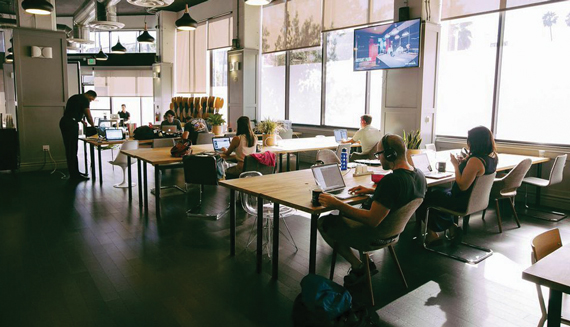Jill Bigelow didn’t plan on building her postpartum medical device company in Hollywood. Then WeWork discovered her at an innovation contest and pitched her on its co-working space located on Hollywood Boulevard, three blocks from tourist mecca Hollywood & Highland.
Mama Strut, as her company is known, is one of many nonmedia companies that have become rooted in the new Hollywood, a nexus for entertainment, technology and design professionals. When Bigelow ended up needing some video production work done, she only had to look one floor above her in the WeWork space. And she hired the website guy from another floor downstairs.
Megadeals like the one Netflix inked at Icon — a new 323,000-square-foot tower on the Sunset Bronson Studios lot, which the streaming media company leased in its entirety — have shone a spotlight on high-tech office leases. But not all of the businesses attracted by the new and renovated offices in Hollywood fit neatly into the stereotype of new technology and entertainment companies.
A mile east of WeWork, near a district landmark, the Pantages Theatre, the historic Taft Building sits at the crossroads of old and new Hollywood. In the early days after the 12-story Classic Revival style building opened in 1923, it housed the offices of Charlie Chaplin and the Academy of Motion Picture Arts and Sciences.
 Like many stars who’ve been around a while, though, the Taft Building needed a facelift to stay in the game. New York-based DLJ Capital Partners bought the building for $28 million in 2011and has since infused $15 million into the adaptive reuse of the 119,046-square-foot property. Rents in the Killefer Flammang Architects-renovated office building range just over $4 per square foot, about on par with comparable properties elsewhere in Hollywood. (Some top Hollywood Class A buildings ask $4.50 per square foot.) By comparison, rates for Class A space average $4.92 a foot in Playa Vista and $5.38 in Santa Monica.
Like many stars who’ve been around a while, though, the Taft Building needed a facelift to stay in the game. New York-based DLJ Capital Partners bought the building for $28 million in 2011and has since infused $15 million into the adaptive reuse of the 119,046-square-foot property. Rents in the Killefer Flammang Architects-renovated office building range just over $4 per square foot, about on par with comparable properties elsewhere in Hollywood. (Some top Hollywood Class A buildings ask $4.50 per square foot.) By comparison, rates for Class A space average $4.92 a foot in Playa Vista and $5.38 in Santa Monica.
Above the tourists snapping photos of the stars on the Hollywood Walk of Fame, apparel maker Represent has created its own industry niche. It helps customers manufacture custom clothes (most are social campaign-oriented) with no capital outlay, taking a cut of the gross margins.
Raucous, another Taft building tenant, is a more traditional media play, producing TV commercials. When co-owner and executive producer Steve Wi started scouting out a new location after 11 years at Hollywood Center Studios, he chose to move off the traditional studio lot. “Being over here, there’s definitely a buzz,” he said. “There is so much constantly happening.” By comparison, Wi said, the studio lot felt isolating.
“All the big moves to Hollywood have given these smaller tenants much more confidence,” said Carle Pierose of Industry Partners, the building’s leasing agent. And he said the Taft Building’s address has another advantage: “Everyone knows where Hollywood is.”
The turning point
Market watchers agree that the neighborhood’s revival accelerated with Kilroy Realty’s redevelopment of what is now called Columbia Square, located in the longtime home of CBS’s L.A. radio and television operations, where radio classics like the Jack Benny show and the TV drama “Gunsmoke” were produced.

WeWork Hollywood
Kilroy bought the 4.7-acre property for $65 million in 2012, acquiring the site’s three historic office buildings, totaling about 96,000 square feet. At the time of the purchase, the complex was already entitled to add retail and multifamily. Kilroy broke ground in 2014.
CBRE Vice Chairman Todd Doney said the redevelopment brought the first real Class A office space to the Hollywood business district in many years. When Viacom signed a lease for 180,000 square feet at Columbia Square in 2014, Doney said, “it validated the marketplace.”
Although many traditional media companies have taken space in the television network’s former home — Viacom moved there, bringing the channels it owns, including Comedy Central and MTV, along with it — some of the tenants come from farther afield.
Fender Guitars has leased 40,000 square feet, as has Global Brands Group —the brand manager of apparel brands such as JLo by Jennifer Lopez and Juicy Couture. Luxe co-working concept NeueHouse has 93,000 feet. By the end of 2016, the office complex was 95 percent occupied, according to Carl Muhlstein of JLL.
But the groundwork for the neighborhood’s revival had been laid some years earlier, when the city invested $110 million in redevelopment agency funds at Hollywood & Highland and expanded the Metro Red Line to run between North Hollywood and Downtown Los Angeles.
Up until that point, Hollywood had been a relatively unpleasant, crime-ridden cityscape that many Angelenos avoided. But the public transportation and redevelopment funds helped spark an urban revival.
Today, market pros compare Hollywood with the renaissance in DTLA’s Arts District. “The markets are similar in that they have this combination of retail, residential and office that is so attractive to the millennial workforce,” said CBRE’s Doney.
